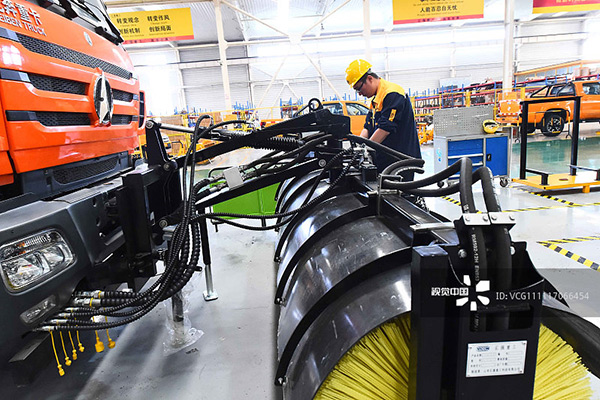
A worker operates a snow-sweeping vehicle assembly line in Weifang, Shandong province.[Photo/China Daily]
A highly influential manufacturing survey has showed that China’s economy is picking up at a faster pace than analysts predicted.
The official manufacturing purchasing managers index, a key gauge of factory activity, came in at 51.7 percent in June, which was better than expected.
It was also at its highest mark in three months and signaled that growth in the world’s second-largest economy is picking up, despite financial tightening.
“The rising PMI and expansion of the manufacturing industries in June indicate that the economy is stepping out of weakness and is becoming more resilient,” a research note from Guotai Junan Securities stated.
The PMI is a survey conducted among Chinese manufacturers to highlight business confidence in the industry. A reading of 50 or above shows manufacturing is expanding. A below 50 figure illustrates a contraction.
Last month’s reading of 51.7 was higher than May’s figure of 51.2 and marked the 11th consecutive month of expansion, according to data released by the National Bureau of Statistics on June 30.
New orders accelerated for the domestic sector as well as for the export market.
New orders in June, as shown in a sub index of the PMI, increased to 53.1 from May’s 52.3, while export orders jumped to 52, 1.3 percentage points higher than in May.
“Exports have recovered at a pace that beats market expectations,” said Ren Zeping, chief economist of Founder Securities.
“The US, European and Japanese economies have all improved, with the European economy accelerating, which will benefit China’s export-related industries,” he added.
New orders in the construction sector, another sub index of the PMI, were 55.4 percent in June, a jump of 1.3 percentage points compared to May.
“This shows that market demand is strong and enterprises are confident,” said Ren.
The service sector, which accounted for more than half of the country’s GDP last year, saw robust growth last month, with the sub index coming in at 53.8, up from 53.5 in May.
Also, for the first half of the year, non-manufacturing PMI averaged 54.6, higher than the 53.4 during the same period in 2016, NBS data showed.
China reported year-on-year GDP growth of 6.9 percent in the first quarter, beating market expectations and the country’s target of around 6.5 percent.
Still, analysts have warned that the economy could start to slow slightly in the second half of the year.
“We forecast that GDP growth will be about 6.8 percent in the second quarter and the economy will continue to be resilient in the third quarter,” the research note from Guotai & Junan Securities stated.
China has intensified its financial tightening policy in recent months to prevent potential economic risks.
Li Daokui, an economist of Tsinghua University, stressed on June 28 that growth could slow in the third quarter. “Growth will gradually pick up and could reach 6.9 percent next year,” Li said.
Zhu Min, an economist of Tsinghua University and former deputy managing director of the IMF, pointed out on Wednesday that the economy has undergone profound structural changes.
Consumption is making an increasing contribution to growth and jobs, while investment remains strong, Zhu said during the Summer Davos in Dalian, Liaoning province.
“I’m optimistic about China’s economic momentum next year and its structural reforms have laid foundation for future growth,” he said.
